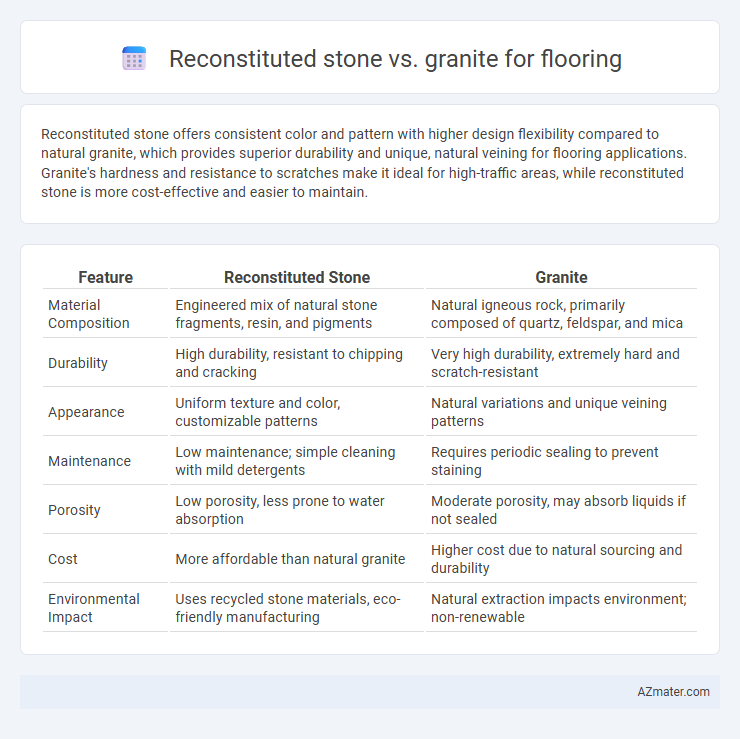Reconstituted stone offers consistent color and pattern with higher design flexibility compared to natural granite, which provides superior durability and unique, natural veining for flooring applications. Granite's hardness and resistance to scratches make it ideal for high-traffic areas, while reconstituted stone is more cost-effective and easier to maintain.
Table of Comparison
| Feature | Reconstituted Stone | Granite |
|---|---|---|
| Material Composition | Engineered mix of natural stone fragments, resin, and pigments | Natural igneous rock, primarily composed of quartz, feldspar, and mica |
| Durability | High durability, resistant to chipping and cracking | Very high durability, extremely hard and scratch-resistant |
| Appearance | Uniform texture and color, customizable patterns | Natural variations and unique veining patterns |
| Maintenance | Low maintenance; simple cleaning with mild detergents | Requires periodic sealing to prevent staining |
| Porosity | Low porosity, less prone to water absorption | Moderate porosity, may absorb liquids if not sealed |
| Cost | More affordable than natural granite | Higher cost due to natural sourcing and durability |
| Environmental Impact | Uses recycled stone materials, eco-friendly manufacturing | Natural extraction impacts environment; non-renewable |
Introduction to Reconstituted Stone and Granite
Reconstituted stone is an engineered material composed of crushed natural stone bound with resin or cement, offering consistent texture and customizable color options. Granite, a natural igneous rock, is prized for its durability, unique patterns, and resistance to scratches and heat. Both materials are popular for flooring due to their strength, but reconstituted stone provides greater design flexibility while granite offers unmatched natural beauty.
Composition and Manufacturing Process
Reconstituted stone, also known as engineered stone, is composed of crushed natural stone mixed with resin and pigments, resulting in a highly customizable and uniform material. Granite is a natural igneous rock mined directly from quarries, cut, and polished without additives, preserving its unique mineral composition and natural variations. Manufacturing reconstituted stone involves blending raw materials under controlled conditions and curing them with resin, whereas granite flooring relies on precise cutting and finishing of solid stone slabs.
Aesthetic Differences and Design Options
Reconstituted stone offers uniform patterns and a wider range of customizable colors compared to granite's natural, unique veining and organic textures. Granite flooring provides timeless elegance with distinct mineral variations that enhance classic and rustic designs, while reconstituted stone suits modern interiors requiring consistent appearance and innovative finishes. Both materials deliver durability, but design preferences often hinge on whether a natural or engineered aesthetic is desired.
Durability and Strength Comparison
Reconstituted stone offers consistent durability and resistance to chipping, making it suitable for high-traffic areas, while granite boasts superior natural strength and exceptional hardness due to its crystalline structure. Granite's high compressive strength, often exceeding 200 MPa, provides enhanced longevity and resistance to wear compared to reconstituted stone, which may contain resin binders affecting its overall toughness. Both materials are durable options for flooring, but granite's natural composition typically results in greater strength and long-term performance under heavy use.
Maintenance Requirements
Reconstituted stone flooring demands less frequent sealing and exhibits higher resistance to stains compared to natural granite, reducing upkeep efforts significantly. Granite requires routine sealing and periodic polishing to maintain its resistance to scratches and moisture, increasing long-term maintenance. Both materials benefit from regular cleaning with pH-neutral products, but reconstituted stone's engineered composition offers enhanced durability in high-traffic areas.
Cost Analysis and Budget Considerations
Reconstituted stone flooring offers a cost-effective alternative to natural granite, with prices typically 30-50% lower due to the use of engineered composite materials. Granite, while more expensive upfront, provides superior durability and longer lifespan, potentially reducing replacement and maintenance costs over time. Budget considerations should weigh initial installation expenses against long-term value, factoring in material costs averaging $7-$25 per square foot for granite versus $5-$15 for reconstituted stone.
Environmental Impact and Sustainability
Reconstituted stone flooring, made from recycled natural stone and binding agents, significantly reduces quarrying waste and lowers carbon emissions compared to granite, which requires extensive mining and processing. Granite, despite its durability and natural origin, has a higher environmental footprint due to energy-intensive extraction and transportation processes. Choosing reconstituted stone supports sustainability goals by minimizing resource depletion and promoting recycling of stone byproducts.
Installation Process and Challenges
Reconstituted stone offers a more uniform surface and easier cutting process compared to granite, simplifying installation and reducing labor time. Granite requires specialized tools and skilled craftsmanship due to its natural hardness and variability, increasing installation complexity and cost. Both materials demand proper subfloor preparation and sealing, but reconstituted stone's modular manufacturing minimizes cracking risks during installation.
Suitability for High-Traffic Areas
Reconstituted stone offers enhanced durability and uniformity, making it highly suitable for high-traffic flooring due to its engineered resistance to wear and staining. Granite, a natural stone, boasts exceptional hardness and longevity, maintaining its aesthetic appeal even under heavy foot traffic and abrasion. Both materials provide strong performance, but reconstituted stone's consistent composition often results in easier maintenance in commercial or heavily used residential spaces.
Conclusion: Choosing the Right Stone for Flooring
Reconstituted stone offers consistent color and pattern with enhanced durability, making it ideal for cost-effective and uniform flooring solutions. Granite provides exceptional natural beauty, unparalleled hardness, and long-lasting resistance to scratches and stains, perfect for high-traffic or luxury flooring applications. Selecting between reconstituted stone and granite depends on budget, aesthetic preferences, and the specific demands of the flooring environment.

Infographic: Reconstituted stone vs Granite for Flooring
 azmater.com
azmater.com